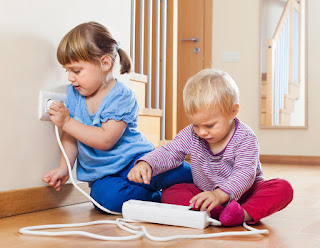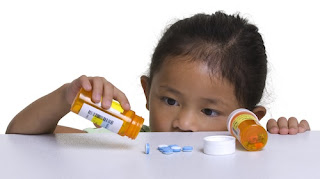Kids and toddlers are playful in and around the house. Of course, parents and nannies always look after the small ones and try to keep a safe environment for them to play in. However, hidden dangers always lurk around the home. While many household items are considered safe, some common household stuff are actually dangerous or even fatal for children and infants. Parents and nannies should know more and learn these things in order to avoid possible accident.
Advertisement
Sponsored Links
1. Electric Sockets and Electrical devices.
In their crawling and walking process, it’s really easy for small children to get near these dangers. While a socket cover can be used to prevent children from inserting objects in an electrical socket, this is not a fool-proof way to prevent accident. Some socket covers are even attracting children towards sockets due to their attractive designs or colors - as children mistake them for toys. Similarly, children often copy what adults do, including when we plug chargers or other electrical items into a socket.
To prevent accident, install plain color socket covers. You can also tape over sockets that are not being used. Use a wide and clear scotch tape. Keep children's play area clean and keep very small items like paper clips out of their reach. This stops them from getting curious and inserting such into sockets. It also prevents accident number 3 on this list.
2. Small Items, Tools and Food
From coins, colorful buttons, batteries, paper clips, and even food like berries, nuts or candies - all of these are choking risks. Infants often put things in their mouths, even small toys. They misunderstand that they’re food and swallow them. Keep them out of reach!
3. Medicine
Kids mistake medicines for candies because they almost exactly look alike. They can’t distinguish them, and are not aware of their dangers either. Adults should put medicine out of children's reach. Kids medicine should also be separated from adult medications.
4. Mugs and Glass wares
There are two dangers associated with pottery and glassware. The first is of course broken glass or pottery shards. Children are not used to these utensils, and they are not yet fully aware of the consequences of breaking glass wares - including the danger of getting cuts. Be aware and quick when you hear the sound of breaking glass.
The second danger is about heat. Mugs and glassware do not necessarily insulate from heat. Hot objects can cause burns in children. Children should only use plastic or metal cups, or adults should hold the cups for them until they are ready. Also, teach children the concept of hot by letting them experience the sensation gently.
5. Kitchen wares
From kettles to pans to the stove and oven, kids should not play and linger around the kitchen. Even when you have finished cooking dinner, the stove and pot is still hot for up to half an hour or more. Placing your pan where the handle is hanging out of the stove area is also dangerous since kids randomly grab things, and they could grab the handle and spill hot oil all over. The oven is especially dangerous since kids like paying hide and seek. We don't even need to mention knives and other sharp and pointy tools. Supervision is the key to safety.
6. Bath tubs, Fish Tank or any open Water Container
Things that contain water are harmful to children to a certain degree. Children like playing, especially with water. Leaving them playing alone near such things is very dangerous. Kids may fall into one of these and drown. Even in situations where the water level is low, the potential threat cannot be underestimated. Washing machines are included in this risk.
An infamous case of this happened to an OFW in Singapore in 1991. Flor Contemplacion was sentenced to death for the alleged murder of fellow OFW Delia Maga and her 4-year old ward. It is believed though that the child died from accidental drowning in a pail of water, and the father killed Maga out of anger. The blame was put to Contemplacion.
7. Window blind cords and Plastic bags
Nearly 17,000 young children were hurt by window blinds between 1990 and 2015. While most injuries were minor, almost 300 died have died. Most deaths occur when children became entangled or strangled by the cords. Plastic bags cause similar fatal accidents due to suffocation. The problem in these situation is that the children in danger cannot make noise or cry while suffocating or getting strangled, making this situation even more dangerous.
8. Shelves and Cabinets
Kids like climbing. Book shelves, closets, TV stands and display cabinets are their favorite to climb because it’s easy to get to them and they usually have handles and layers that look like steps on a ladder. However, without a firm base, these shelves can easily fall, hurting the playful kids. In order for their safety, parents should keep these shelves stable and firm in the base so that they can’t fall easily. Taller cabinets can also be mounted on the wall using brackets.








